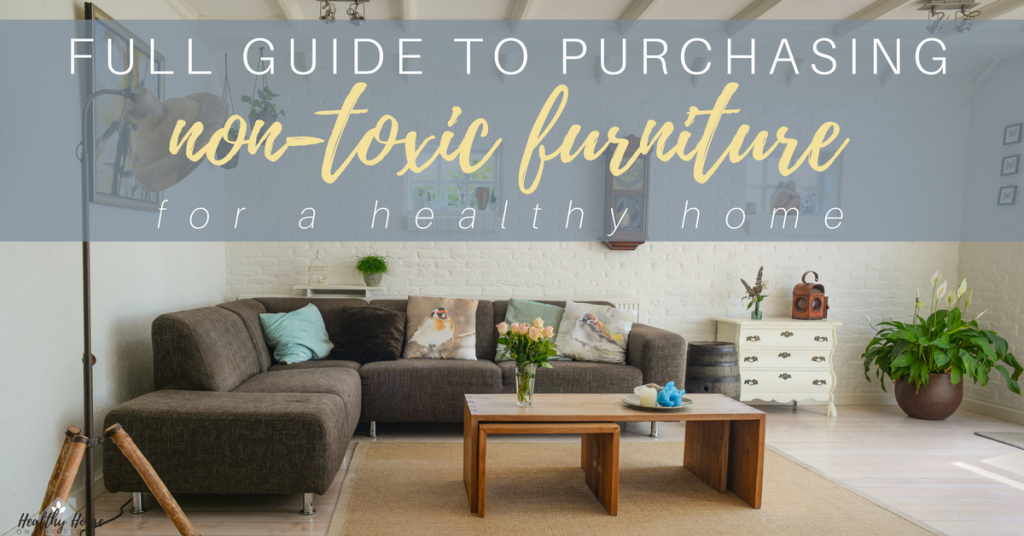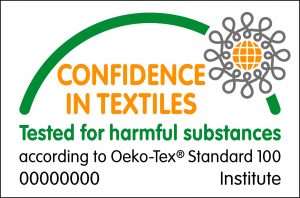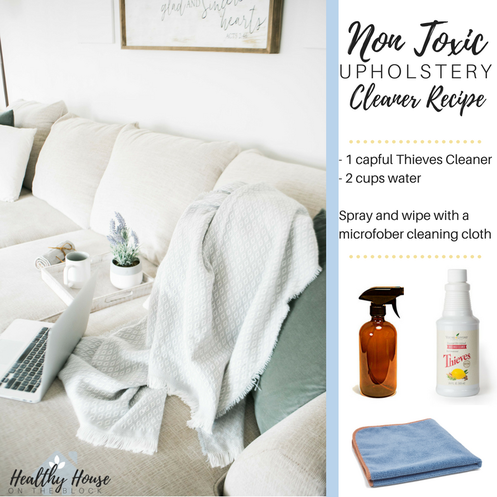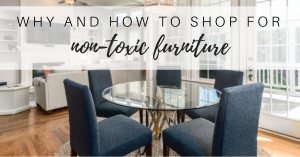
Furniture in our homes is what creates the feeling you get in a space, it elevates the comfort factor and it is usually the focal point of the whole room. Most of us would agree that furniture is one of our largest purchases, and one that gets the most use. For my family our furniture is definitely a large part of each and every room we have, from our couches to our kitchen table, to our dressers and beds. These pieces make up each and every room and we put them to good use every day.
But what we fail to remember often times is that by purchasing a new piece of furniture and introducing it to our indoor space, we are also bringing in potentially harmful chemicals. The biggest problem with bringing toxic chemicals inside our homes is we often offer very little ventilation to the new furniture and keep all the chemicals trapped inside our homes.
Chemicals brought into the home through furniture and furniture manufacturing not only remain in our homes for a long time due to little ventilation of fresh air, but they will continue to off-gas for the lifetime of the furniture. Some toxins actually off-gas more as they mature in age, meaning you’ve just introduced a long-term toxin source to your indoor air.
Furniture like couches, chairs and beds have the potential to off-gas at higher rates than other sources around your home. Many chemical toxins release their VOCs into the air at higher rates when the environment around them is warm and has higher humidity. Think of when someone sits on a sofa. The sofa cushion is warmed by the body heat and the skin is often releasing some sort of moisture, creating a humid environment for the cushion to off-gas at a higher rate every time someone uses it.
Still yet another problem with allowing toxic furniture into our homes is the sheer amount of time we are spending on them, sitting, sleeping and resting. When we’re spending this much time on our furniture, it means not only is our skin often times in contact with these toxins for an extended period of time, but often times our faces are in extremely close proximity. In other words, we are breathing in many of these toxins in close range when we’re using these furniture pieces.
If you’re in the market for new furniture, there are many great options and some very specific things you can look for and avoid. And if you’re not in a position to change out all your furniture, there are definitely great ways to work with what you have.
Buying New Furniture: What to Avoid

Buying new furniture is a huge undertaking when you’re looking for the right style, correct size, and comfort preferences. The great thing is that you can go into that purchase armed with the exact information you need when it comes to what toxins and chemicals to try and avoid.
BENZENE
Benzene is often found in dyes, waxes and resins found within furniture. While many fabrics are created with synthetic dyes, not all of them contain Benzene, so it’s important to check with the manufacturer.
Benzene has been linked to a higher risk of leukemia in children as well as adverse reproductive effects in adults. It’s also been studied as a contributor to multiple blood disorders.
VINYL ACETATE
Vinyl acetate is a component of polyvinyl and is found in strong furniture adhesives as well. Some painted furniture contains vinyl acetate, and so it can be difficult to find out if this toxin is used in the paint. Oftentimes manufacturers use different paints at different production times, and so it’s not always consistent.
Vinyl acetate has been shown to cause increased inflammation (especially in the digestives system and joints) as well as increased respiratory illness and irritation. If you can find a furniture manufacturer that advertises the use of Zero VOC paint, that will be your best bet in avoiding the toxin in paints.
FLAME RETARDANTS
Flame retardants are now found in just about every piece of foam furniture. They are used in everything from mattresses to foam found in couches and chairs. Flame retardants are especially dangerous as they fall into the category of extremely high off-gassing rates when in a warm and humid environment. Some flame retardants are labeled as PBDE and are starting to become a widely recognized toxins source. Looking for a natural flame retardant such as organic wool is helpful in replacing this chemical.
PBDEs have been linked to many problems, most of which occur in children. Neurological effects are widely studied and connected to the toxins in flame retardants as are developmental delays in children. Research has also shown that PBDEs disrupt the hormone production of certain hormones in some individuals, which can lead to fertility issues, weight problems and problems with mental clarity.
STAINS/VARNISHES WITH VOCs
Stains and varnishes more often than not contain VOCs. If a stain or varnish is zero-voc, it will most likely state that fact as it is hard to come by. VOCs are a known carcinogen and can be extremely toxic as they never truly stop off-gassing. They are often times the strongest when first applied, but they continue to off-gas for the lifetime of the furniture piece. Almost every furniture piece within a home contains some sort of varnished or stained wood. It could be the main component, such as a dining room table that we’re eating off of, or it could be the legs of a chair or sofa,which may not contribute as many VOCs to the air, but will still affect it in some way.
It’s easiest to avoid VOCs in stains and varnishes and you can often find this advertised with some furniture companies. You can also look for some different third party certifications to verify that they are in fact VOC free.



STAIN RESISTANT FURNITURE
Furniture and surfaces that resist stains and liquid absorption are often coated in a spray containing PFCs or Perfluorochemicals. These are highly toxic and are the same chemicals that are used in teflon cookware. Where I live in Minnesota, there has been several cases of cancer linked to the improper disposal of these chemicals where they have contaminated drinking water. If this product is THAT toxic, it should not be used in furnitures or carpets. But unfortunately, it still is used.
These chemicals create an increased risk of cancer as well as kidney and liver toxicity. Another factor that comes into play with this chemical is that it takes a very long time to leave the body after it is absorbed into the bloodstream. It has been found in urine and breastmilk long after exposure has occurred.
FORMALDEHYDE
Most of the time we don’t consider this to even be in furniture as we KNOW that it’s a chemical toxin. But the truth of the matter is that it is in many furniture pieces. Formaldehyde is used in the strong adhesive glues in many pressed woods. Furniture that is made with medium density fiberboard, plywood and particleboard often times uses these strong adhesives and many times there is formaldehyde present.
Formaldehyde is also present in wrinkle-free fabrics, like those found in plush chairs and on couches. Formaldehyde is in an agent added to the fabric fibers that prevents the fabric from wrinkling.
We know from studies and research that Formaldehyde is a carcinogen to the human body and should be avoided. We also know that formaldehyde is a chemical toxin that does not leave the body very quickly. Once it enters the bloodstream through the skin or through inahalation of VOCs, it spends a long time traveling through the body, affecting many areas and systems.
Formaldehyde, like other toxins, off-gasses at a higher rate in the perfect environment. This is a warm, humid environment, which is especially concerning when it comes to furniture. As mentioned earlier, the heat from a body sitting on the furniture and the moisture from skin creates an optimal environment for the formaldehyde to off-gas at a high rate.
Looking for solid wood furniture is one of the best options and when it comes to fabrics, looking for a third-party seal is going to be a great tool.
PHTHALATES
Plastic furniture is a really popular choice right now and it’s especially popular for dorm rooms and kids play rooms. But plastic furniture is truly not the best choice when it comes to the health of our indoor air and indoor environment. Plastics are filled with phtalates, which are becoming a well-known problem in terms of our health. Plastics with phthalates are a known hormone disruptor and eventually lead to reproductive problems in both women and men.
If plastic can be avoided, it’s best to do so and opt for a product that is natural instead. Try to opt for solid wood or metals as an alternative. More natural pieces will most likely last much longer as well given the quality of the materials used.
Looking for furniture can be a daunting task, but by using this guide, you can know exactly what to ask manufacturers.
GET THE COMPLETE FURNITURE REFINISHING GUIDE

WORKING WITH WHAT YOU HAVE
It’s not always an option to buy a whole new furniture set and oftentimes we are left to work with what we’ve already purchased. The good news is there are ways to minimize the effects that our furniture has on our indoor air quality.
Some great ways to work with what you have are below and can help minimize the toxins that off-gas into the air.
BAKING SODA: Simply sprinkle baking soda on your furniture and let it sit for as long as possible. Use your vacuum brush attachment to vacuum up the baking soda. This will help neutralize the toxins. Toxins and VOCs are generally acidic in nature and by using baking soda, which is alkaline, they become neutralized. A bonus is that baking soda is also a deodorizer and can help remove the scent of synthetic fragrances.
AIR OUT YOUR HOME/ROOM: By bringing in fresh air, it gives your home a chance to dilute the toxins within the air inside. A well-ventilated home by either natural ventilation like windows or mechanical ventilation such as HVAC systems and air-to-air exchangers is a house that has more fresh air than other homes. By bringing in fresh air we are diluting the toxin-filled air and creating a healthier space to live.
CHARCOAL FILTERS: If you have a furnace or whole house fan that allows you to use a filter of some sort, opting for a charcoal filter is a great option. This type of filter can actually help remove lingering VOCs in the air. It’s highly absorbent and can remove dangerous gases. Make sure you change out the filter frequently for the optimum results.
OFF-GAS OUTSIDE: If you can let a piece of furniture off-gas for a period of time outside, that’s the best option. Usually, this is done upon purchasing the furniture as the toxins are often times the strongest when you first receive it. If you can’t bring the furniture outside, you can also let it off gas in a garage or in a spare room with an open window. Remember, it can take up to 6 months for a new piece of furniture to fully off-gass the toxins.
LOWER HUMIDITY LEVELS: While this can be a bit of a challenge, especially for those of us living in the Midwest where temperatures and humidity levels fluctuate between extremes, it’s best to keep the humidity in your home at the low end. If you can do this, it will also help your furniture and other materials in your home off-gas at a lower rate. A cooler indoor climate will also help achieve this as well.







I am aware of the problems with toxics in furniture and I have not found a store that
sells cushions filled with latex or formaldehyde
free fabrics. Also, I think buying upholstered furniture online is really taking a chance.
I have 20 year old sofas and a house that is aired out frequently. So is my furniture already detoxified? Can I just keep it and buy latex
online to replace the old foam in the cushions?
Thanks Amanda for you articles and attention.
Sara Reed
Hi Sara! Replacing cushion foam is a great idea and a great way to get a low toxin piece of furniture without breaking the bank on buying new. I think any small change made is a great improvement in your space. Many of us live with old furniture that has toxins, so remember that you’re still doing more than most!
Hi, I read your article and while you state the problem, I don’t see a solution. Does non toxic furniture event exist? Do you have examples of where we can get these pieces or stores/websites to look at? Because there are no solutions or alternatives listed, it feels like an alarming article with no solution. Many people don’t know how to research the things you shared and just need suggestions of what companies to look at.
Thanks for your comment, Elizabeth! I have published a few posts about furniture companies specifically after this one was published. There are some great options (Savvy Rest and The Futon shop are two of my favorites). Thanks so much for your input!